

 Vol. 40 (Number 8) Year 2019. Page 29
Vol. 40 (Number 8) Year 2019. Page 29
FABRE, Paolo G. 1
Received: 09/11/2018 • Approved: 11/02/2019 • Published 06/03/2019
ABSTRACT: The aim of this research study is to analyze how people’ life-history influence their academic and instructional decision. To do so, it was applied a duoethnography study framed by an interpretivism theoretical-foundation based on a constructionism epistemology. It was also implemented some research techniques like semi-structured in-depth interviews, critical-journals, and transcripts to gather the information and the analysis was conducted through an inductive process based on dual learning and inquiry conversations, considering the learning partnership model (Baxter & King, 2004). |
RESUMEN: El objetivo de este estudio es analizar como las historias de vida de la personas influencian sus decisiones académicas/instrucción. Para lograr esto, se aplicó un estudio duo-etnográfico enmarcado con una fundamentación teórica de interpretación basado en epistemología constructivista. También fueron implementadas algunas técnicas de investigación como entrevistas semi-estructuradas, diarios críticos y transcripciones para recolectar la información; el análisis fue realizado a través de un proceso-inductivo basado en aprendizaje-dual y conversaciones considerando un modelo de aprendizaje-de-parejas (Baxter & King, 2004). |
Life is a vivid process that each person experience differently, involving unique and relevant situations that guide people to construct a meaning of their reality, and to shape their personalities, their critical thinking, their passions, their beliefs, their behavior, and even their reactions to everyday activities. People life stories are powerful sources of information to break a phenomenon into small analytical units to understand it as a whole, considering its structure and purpose in order to learn more about race, socio-economic issues, policies, human behavior, and educational programs, among others. When people engage with others in an inquiry conversation, they gain so much meaningful insights to uncover and to perceive the world from a different perspective. This inquiry process even supports people to understand their own way of being and how they define concepts through an exploration of the primary sources of their ideas and assumptions, i.e. why do they believe what they believe? And why do they act in the way they do? However, our life histories do not only affect our way of being and help people to better understand social issues, but it also has an influence on our current academic beliefs, considering studies, professional practice, and research interests.
This study paired two graduated doctoral students for a month to explore the ways in which a person’s life histories shape him/her in the current moment of his/her academic life, and how people explore, integrate, resist, and accommodate with and against theses life histories elements when working on research projects. This research study is framed with an interpretivism theoretical framework, based on a constructionism epistemology. The study required the implementation of Duoethnography research methodology (Sawyer & Norris, 2009), which is grounded on the belief of dual learning through inquiry conversations, and a Learning Partnership Model (Baxter & King, 2004), which is grounded on the notion that individuals take action for their own good as well as the community through a learning partnership. Furthermore, some research techniques were applied such as semi-structured in-depth interviews, critical journals, and transcript to gather the data, which was interpret through an inductive data analysis process.
This research is guided by the following questions: a.) In what ways does the participants’ life histories shape their current experiences as a scholar in training? b.) What are some perspectives that the participant and researcher share about their life histories and academic journey?, and c.) What transformative role, if any, does duo-ethnography play in informing the research project?
The methodology includes the duo-ethnography approach.
According to Sawyer and Norris (2013), who are the pioneers of this research method, duoethnography is a conversation, which fosters the generation of new meaning of any aspect. Ellis, Adams, and Bochner (2010) claimed that, duoethnography is a critically
framed for qualitative research method based on personal experience, whist Ceglowski and Makovsky (2012) claimed that it provides a good promise, providing meaning based on events that were relevant in people’s lives like schools, television, family issues, etc.
Duo-ethnography interrogates the cultural contexts o autobiographical experiences
in order to gain insights into their current perspectives on an experience of issues
related to personal and professional identities (Breault, 2016). During this type of research method, abilities, knowledge and experiences are recalled and explored in conversation with another (Sawyer & Norris, 2012). Duoethnography includes a focused, juxtaposing life experiences to reveal different social and cultural formation, i.e. the nature of identity (Sawyer & Norris, 2012). According to Mezirow (1991) adult development, autonomy, and independent thinking are core components and outcomes of transformative learning in this research method, as well as “transform educational leadership” (Guerra & Nelson, 2006) and “compare and contrast ideas” (Sawyer & Norris, 2015).
Duo-ethnography has recently become a strong research method to uncover a phenomenon and to propose innovation based on people life histories. For example, Snipes and LePeau (2017) conducted a study in which they paired a faculty scholar and a graduate student to explore duoethnography as a transformative learning strategy, working on learning construction and enhancing teaching efficacy. In addition, Guerra and Pazey (2016) carried out a research study that involved the exploration of two faculties members lived experiences to promote an effective leadership program, based on their constructed perspectives and meanings of diversity and social justice. Ceglowski & Makovsky also (2012) conducted a duoethnography study which involved children to better understand the concept and procedures when conducting qualitative research based on duo-ethnography approaches. Finally, Breault (2016) carried out a research, which aimed to provide an integral methodological framework as a transformative process to apply duoethnography studies.
This duoethnography study included two doctoral students as the sample; one of the students is from Jacksonville, Florida. He is a retired, divorced, 59, officer who has four children. He graduated from college and obtained a bachelor degree in administration, and two master degrees in: Administration and Adult Education. The other student is from Guayaquil, Ecuador. He is a single, 28, English as a Foreign Language (EFL) teacher in his own country. He obtained a bachelor and master degree in Education, and some professional teaching and language development training courses in his own country and in The United States.
The data was collected and analyzed for a month through an inductive process [Figure 1], beginning with a conversation as the first encounter between the two graduated students. They set an interview, and during the interview they were filling a critical journal, which includes relevant ideas from the interview, and a documentation of their thoughts, feelings, emotions, and ideas that emerged during the interview using analytical memos. Transcript, coding, and a preliminary analysis previously to conduct a new meeting was necessary to guide the second interview. Thus, the data collection basically included: recorder online semi-structured in-depth interviews [Figure 2], critical journal [Figure 3], conversational power-sharing interviews to clarify understanding, and transcripts.
Figure 1
Inductive Data Analysis Process
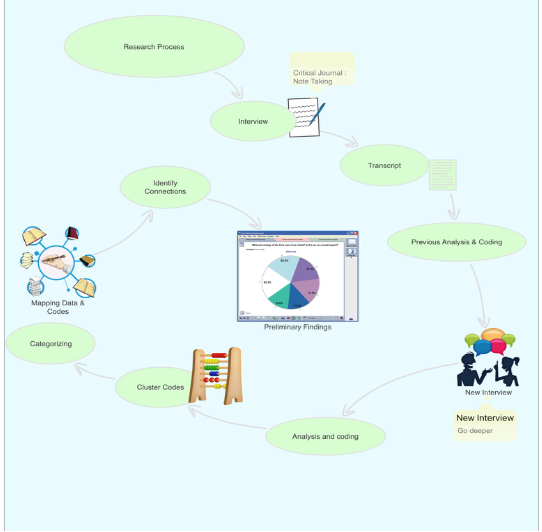
-----
Figure 2
Online semi-structured and in-depth interviews
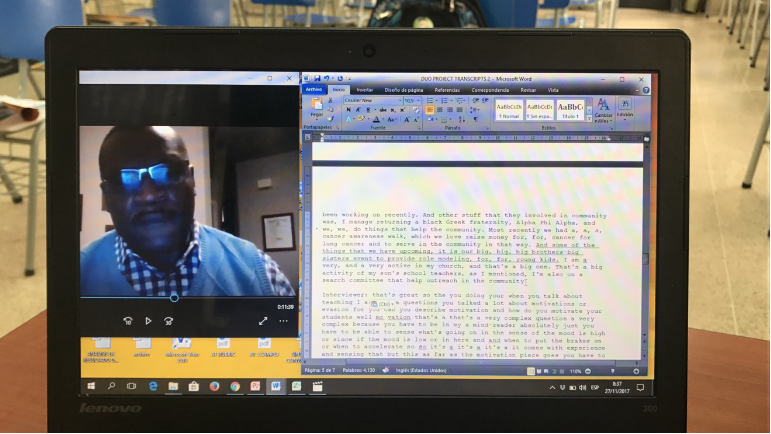
The data was analyzed and broken into small units or codes using a color coding strategy [Figure 3], and then it was clustered into groups, considering preliminary connections among them [Figure 4], in which we use in-vivo, attributes, and describe coding strategies (Saldaña, 2016). Then, some categories were assigned to identify main aspects of life experiences, which were repeatedly mentioned by the participant throughout their narratives, considering the patterns and codes that repeatedly appeared along the first and second interview; and also the critical analysis of the notes and memos on the critical journals, which were taken during both interviews [Figure 4].
Figure 3
Color Coding Strategy as a Preliminary Data Analysis Technique
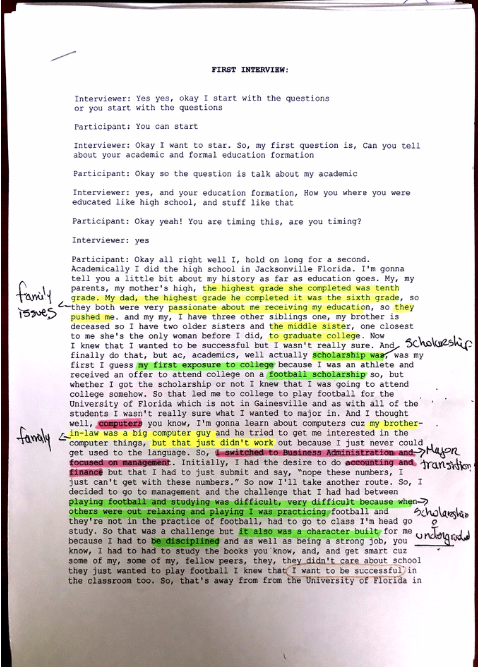
-----
Figure 4
Critical Journal
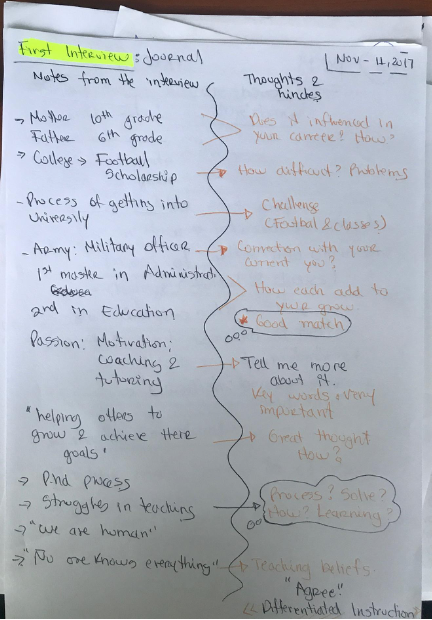
The critical journal was essential during this stage, supporting the researcher to uncover and to understand his own meaning of some concepts, which play an important role at the moment of understanding others’ ideas and assumptions, avoiding that it affects the data analysis process.
Figure 5
Codes and units clusters into groups considering
their nature and common characteristics.
Army Reserve Officer Training Corps (ROTC) Command & general Staff College Be competitive Infantry officers Basic Course Confidence & Self Advocacy Leader Be always prepared Faculty Development Program |
Scholarship Football Athlete Character Building Master in Administration Master in Adult Education Mama bear Dr. Polson The value of getting education: Family |
Motivation Growth Confidence Teaching, coaching, mentoring Scaffolding Encouragement Identity Discussion Instruction is priority Learning It’s not one size doesn’t fit all Public Speaking Critical Thinking When you help others that makes more a different |
Disadvantage youth The Infantry Basic Program Toaster International Speaking Organization Learning Centered Foundation Alpha-Phi-Alpha: Black Greek Fraternity Big-brothers – big-sisters |
Those preliminary analyses permitted the development of some categories and a theme [Figure 6] which inform the research during the subsequent stages.
Figure 6
This chart represents the clusters we develop to analyze the data using themes and categories.
Theme: Service Attitude |
|
Military Service |
|
Academic Background |
|
Teaching Practice |
|
Continuing with the analysis of the data, a mapping process was necessary to find connections among the codes and categories based on a preliminary theme [Graphic 1], which supported me to obtain preliminaries finding that were driven by the research framework and the participant’s constructed meanings. Finally, understanding and reflections were written considering the ideas that emerged from the different stages of the data analysis and the information collected from diverse sources.
Graphic 1
Mapping the ideas, themes and categories to establish general
finding that support the researcher to make conclusions.
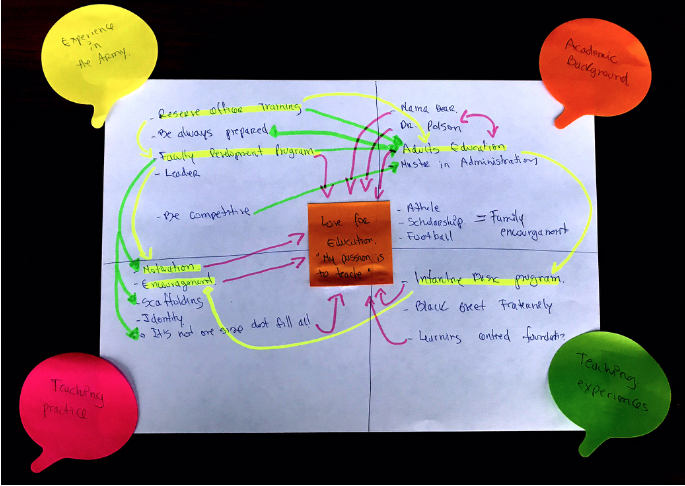
The outcomes of the research portray that the participant has a strong passion and commitment to education, which was shaped by his life’s histories, considering military formation, family background, undergraduate studies, his scholarship experience, two important professors in the process, and different moments he was exposed to mentoring, teaching, coaching, and tutoring. Some of the most relevant moments within his life histories, which shape his current lived experiences as a scholar in training, began with the educational background of his parents…
“The highest grade my mother completed was 10th grade. My dad, the highest grade he completed, it was the 6th grade, so they both were very passionate about me receiving my education,” it was really important for him because he understand that, “they knew the value of getting education and they pushed me.” His family became his first and main pillar, guiding him to want to be successful, “they always encouraged, […], they were able to motivate me.”
The phrases mentioned by the participants in relation to his parents academic histories showed that his primary source of motivation to achieve high level of education, including his current doctoral program is his family. He learned from the very beginning, “the value of getting education.” Later in his life, his passion to education grows, contributing to his attitude of serving, which was displayed on his narrative when he talked about his experience in college, managing a football scholarship…
After several years, he was able to enter to college because he was offered a football scholarship, which was an essential moment on his life, saying that, “the challenge that I had between playing football and studying was difficult, very difficult […], it was practicing, studying, practicing, studying, and practicing,” His days at college were very challenging but “it was also a character built.” Until this moment of his life, he was not very sure about which route he should take, but soon he was going to discoverer that his “passion was teaching, coaching, and mentoring.”
His next life history was essential to understand the connections between his service attitudes, his commitment to change, and his passion for teaching, which shape his current academic, professional, and personal journey…
“My first exposure to formal teaching was in 82 […]; the Entry Definitely Officers Basic Course” in the army. This situation represents a remarkable moment on his life, “when they graduated in February of 86 that was when I said, ‘what I’ve made a difference’ - this is what I want to do.” The passion for teaching and commitment was born, but it also brought motivation to continue learning, concerns, and thoughts. “I thought, it’d be helpful to learn more about how adults learn and grow.” He was prepared in classes, “follow the class step by step” but he also though that, “you never feel like you are prepared enough” and he was scared because of, “not to know how to answer the questions that the students ask;” however, subsequent situations drove him to realize that “it is ok to show that you’re human.”
His experience in the Entry Definitely Officers Basic Course was relevant on his decision making, following his passion and shaping his current academic journey. With a big smile on his face he remembers his first time walking into a classroom as a teacher…
“…When they first came into the classroom the first thing that I did, so I had them go outside and, and, were formed into a formation in the first thing that I did, because I came to class with my sitter. Everybody outside right now, and then I got in front of them, and had them all get down into the push-up position, and we did 50 pushups, right off the bat, and that was there for shocking fit. Let them always be prepared, physically and mentally. And yeah! They thought I was crazy; you know, as a man, he's a MAN, but that was for shock effect because I wanted him to see and to know that as an infantry also you always have to be ready.”
His diverse teaching experiences have driven him to believe that “it’s about motivation and encouragement […] it is about giving back and helping others.” At this moment, his own academic journey is shaped by all his experiences, mentioning that “at this stage of our lives we have to pursue things that interest us.” The analysis of the data helped me to find connections about his passions, pedagogical beliefs, and service attitudes on three phrases: 1.) “I was gonna do it my way but through constant coaching and encouragement and just believe my example,” 2.) “you never know the effect that you have on a student, until you see the results,” and 3.) “I’m not here to make presidents and generals of you, but I just want you to be a productive person.” He also attributes his learning and teaching process, and his current personal and academic profile to two important professors…
“I have two, two professors who are essential in my growth, who introduced me to this Adult Education, and she is, she’s Dr. Polson who kept saying go; and the other is Dr. Collins, Mama Bear; they pushed me.”
Based on the preliminary findings and patterns and codes, which repeatedly emerged during the research process, it is notable that the different small codes of units of the participant’s life histories, good or bad, frame their personality, way of being, identity and that weather he rejects, accommodates or integrates those histories or not, those are relevant aspects of their current professional, academic, and personal moment, which are visually presented on their knowledge, and everyday behavior and reactions.
Findings also reveal that we, the participant and I, share a passion for education, a commitment to change. That we both have been exposed to different teaching experiences, professional teaching development, challenges in education, and have gotten a scholarship. However, each one has different and unique experiences like military services, cultural exposure and interaction, age, time which inform our own perspectives to create new meaning, and which is presented at the moment of interacting or involving in others’ life histories.
Duoethnography approach is an effective way to deconstruct your own meaning of some aspects and concepts, using critical conversation, informing different aspects of qualities research, considering inquiry and understanding of people´s life and their place in society. This study provided me with ideas to understand that my own histories are predominant at the moment of listening and understanding others’ way of being. I do have a meaning already constructed, which I need to deconstructed at the moment of engaging into others’ life histories. Next time, I would extend the interviews, having more sessions to go deeper and deeper.
Baxter Magolda, M. B., & King, P. M. (2004). Learning partnerships theory and models of practice to educate for self-authorship. Sterling, VA: Stylus.
Breault, R. (2016). Emerging issues in duoethnography. International Journal of Qualitative Studies in Education, 29(6), 777-794, doi:10.1080/09518398.
Ceglowski, D., & Makovsky, T., (2012) Duoethnography with children. Ethnography and Education, 7 (3), 283-295, DOI: 10.1080/17457823.2012.717197.
Ellis, C., Adams, T. E., & Bochner, A. P. (2010). Autoethnography: An Overview. Qualitative Sozialforschung/Forum. Qualitative Social Research, 12(1).
Guerra, P. L., & Nelson, S. W. (2006). Five essential components for social justice education. Equity and Excellence in Education, 38(2), 103-109.
Guerra, P. & Pazey, B. (2016). Transforming educational leadership preparation starting with ourselves. The Qualitative Report, 21, (10), 1751-1784.
Mezirow, J. (1991). Transformative dimensions of adult learning. San Francisco, CA: JosseyBass.
Saldaña, J. (2016). The coding Manual for Qualitative Researchers. California, Thousand Oaks: SAGE Publication
Sawyer, R.D., and J. Norris. 2009. Duoethnography: Articulations/(re)creation of meaning in the making. In The collaborative turn: Working together in qualitative research, ed. W.S. Gershon, 127 (40). Rotterdam, Netherlands: Sense Publishers
Sawyer, R. D., & Norris, J. (2012). Understanding qualitative research: Duoethnography. Cary, NC: Oxford University Press.
Sawyer, R. D., & Norris, J. (2013). Duoethnography: Understanding qualitative research. Oxford, UK: Oxford University Press.
Sawyer, R. D., & Norris, J. (2015). Duoethnography. International Review of Qualitative Research, 8(1), 1–4.
Snipes, J., & LePeau, L, (2017). Becoming a scholar: A duoethnography of transformative learning spaces. International Journal of Qualitative Studies in Education, 30 (6), 576-595, DOI: 10.1080/09518398.2016.1269972.
1. Instructor and Educational Researcher. College of education. Milagro State University. Email address: pfabrem@unemi.edu.ec